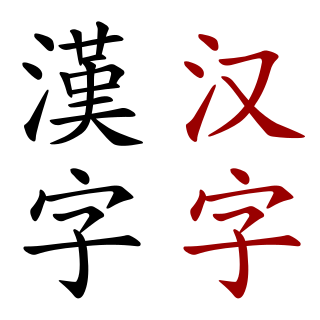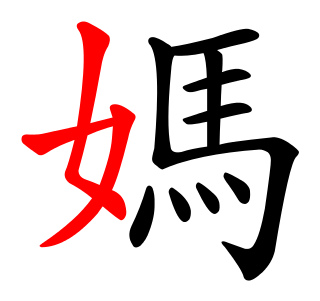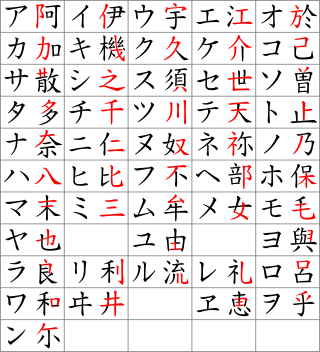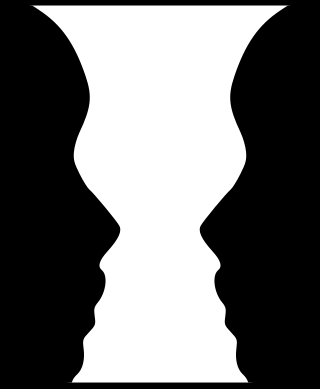Related Research Articles
Kana are syllabaries used to write Japanese phonological units, morae. Such syllabaries include (1) the original kana, or magana, which were Chinese characters (kanji) used phonetically to transcribe Japanese, the most prominent magana system being man'yōgana (万葉仮名); the two descendants of man'yōgana, (2) hiragana, and (3) katakana. There are also hentaigana, which are historical variants of the now-standard hiragana. In current usage, 'kana' can simply mean hiragana and katakana.

Kanji are the logographic Chinese characters taken from the Chinese script, and used in the writing of Japanese. They were made a major part of the Japanese writing system during the time of Old Japanese and are still used, along with the subsequently-derived syllabic scripts of hiragana and katakana. The characters have Japanese pronunciations; most have two, with one based on the Chinese sound. A few characters were invented in Japan by constructing character components derived from other Chinese characters. After World War II, Japan made its own efforts to simplify the characters, now known as shinjitai, by a process similar to China's simplification efforts, with the intention to increase literacy among the common folk. Since the 1920s, the Japanese government has published character lists periodically to help direct the education of its citizenry through the myriad Chinese characters that exist. There are nearly 3,000 kanji used in Japanese names and in common communication.

In a written language, a logogram, logograph, or lexigraph is a written character that represents a word or morpheme. Chinese characters are generally logograms, as are many hieroglyphic and cuneiform characters. The use of logograms in writing is called logography, and a writing system that is based on logograms is called a logography or logographic system. All known logographies have some phonetic component, generally based on the rebus principle.

Gestalt psychology, gestaltism, or configurationism is a school of psychology that emerged in the early twentieth century in Austria and Germany as a theory of perception that was a rejection of basic principles of Wilhelm Wundt's and Edward Titchener's elementalist and structuralist psychology.

Chinese characters are logograms developed for the writing of Chinese. Chinese characters are the oldest continuously used system of writing in the world. By virtue of their widespread current use throughout East Asia and Southeast Asia, as well as their profound historic use throughout the Sinosphere, Chinese characters are among the most widely adopted writing systems in the world by number of users.

A Chinese radical or indexing component is a graphical component of a Chinese character under which the character is traditionally listed in a Chinese dictionary. This component is often a semantic indicator similar to a morpheme, though sometimes it may be a phonetic component or even an artificially extracted portion of the character. In some cases the original semantic or phonological connection has become obscure, owing to changes in character meaning or pronunciation over time.
In psychology, jamais vu, a French loanword meaning "never seen", is the phenomenon of experiencing a situation that one recognizes in some fashion, but that nonetheless seems novel and unfamiliar.

Man'yōgana is an ancient writing system that uses Chinese characters to represent the Japanese language. It was the first known kana system to be developed as a means to represent the Japanese language phonetically. The date of the earliest usage of this type of kana is not clear, but it was in use since at least the mid-7th century. The name "man'yōgana" derives from the Man'yōshū, a Japanese poetry anthology from the Nara period written with man'yōgana.
Okurigana are kana suffixes following kanji stems in Japanese written words. They serve two purposes: to inflect adjectives and verbs, and to force a particular kanji to have a specific meaning and be read a certain way. For example, the plain verb form 見る inflects to past tense 見た, where 見 is the kanji stem, and る and た are okurigana, written in hiragana script. With very few exceptions, okurigana are only used for kun'yomi, not for on'yomi, as Chinese morphemes do not inflect in Japanese, and their pronunciation is inferred from context, since many are used as parts of compound words (kango).

Figure–ground organization is a type of perceptual grouping that is a vital necessity for recognizing objects through vision. In Gestalt psychology it is known as identifying a figure from the background. For example, black words on a printed paper are seen as the "figure", and the white sheet as the "background".
The lexical decision task (LDT) is a procedure used in many psychology and psycholinguistics experiments. The basic procedure involves measuring how quickly people classify stimuli as words or nonwords.

In Japanese language, Ryakuji are colloquial simplifications of kanji.
Semantic satiation is a psychological phenomenon in which repetition causes a word or phrase to temporarily lose meaning for the listener, who then perceives the speech as repeated meaningless sounds. Extended inspection or analysis in place of repetition also produces the same effect.
Strikethrough is a typographical presentation of words with a horizontal line through their center, resulting in text like this. Contrary to censored or sanitized (redacted) texts, the words remain readable. This presentation signifies one of two meanings. In ink-written, typewritten, or other non-erasable text, the words are a mistake and not meant for inclusion. When used on a computer screen, however, it indicates deleted information, as popularized by Microsoft Word's revision and track changes features. It can also be used deliberately to imply a change of thought.
Extended shinjitai is the extension of the shinjitai. They are the simplified versions of some of the hyōgaiji. They are unofficial characters; the official forms of these hyōgaiji are still kyūjitai.
The neuroanatomy of memory encompasses a wide variety of anatomical structures in the brain.
Dyslexia is a complex, lifelong disorder involving difficulty in learning to read or interpret words, letters and other symbols. Dyslexia does not affect general intelligence, but is often co-diagnosed with ADHD. There are at least three sub-types of dyslexia that have been recognized by researchers: orthographic, or surface dyslexia, phonological dyslexia and mixed dyslexia where individuals exhibit symptoms of both orthographic and phonological dyslexia. Studies have shown that dyslexia is genetic and can be passed down through families, but it is important to note that, although a genetic disorder, there is no specific locus in the brain for reading and writing. The human brain does have language centers, but written language is a cultural artifact, and a very complex one requiring brain regions designed to recognize and interpret written symbols as representations of language in rapid synchronization. The complexity of the system and the lack of genetic predisposition for it is one possible explanation for the difficulty in acquiring and understanding written language.
Amorphosynthesis, also called a hemi-sensory deficit, is a neuropsychological condition in which a patient experiences unilateral inattention to sensory input. This phenomenon is frequently associated with damage to the right cerebral hemisphere resulting in severe sensory deficits that are observed on the contralesional (left) side of the body. A right-sided deficit is less commonly observed and the effects are reported to be temporary and minor. Evidence suggests that the right cerebral hemisphere has a dominant role in attention and awareness to somatic sensations through ipsilateral and contralateral stimulation. In contrast, the left cerebral hemisphere is activated only by contralateral stimuli. Thus, the left and right cerebral hemispheres exhibit redundant processing to the right-side of the body and a lesion to the left cerebral hemisphere can be compensated by the ipsiversive processes of the right cerebral hemisphere. For this reason, right-sided amorphosynthesis is less often observed and is generally associated with bilateral lesions.
In neuroscience, the visual P200 or P2 is a waveform component or feature of the event-related potential (ERP) measured at the human scalp. Like other potential changes measurable from the scalp, this effect is believed to reflect the post-synaptic activity of a specific neural process. The P2 component, also known as the P200, is so named because it is a positive going electrical potential that peaks at about 200 milliseconds after the onset of some external stimulus. This component is often distributed around the centro-frontal and the parieto-occipital areas of the scalp. It is generally found to be maximal around the vertex of the scalp, however there have been some topographical differences noted in ERP studies of the P2 in different experimental conditions.

Ideasthesia is a neuropsychological phenomenon in which activations of concepts (inducers) evoke perception-like sensory experiences (concurrents). The name comes from the Ancient Greek ἰδέα and αἴσθησις, meaning 'sensing concepts' or 'sensing ideas'. The notion was introduced by neuroscientist Danko Nikolić as an alternative explanation for a set of phenomena traditionally covered by synesthesia.
References
- ↑ Valsiner, Jaan; Veer, Rene van der (2000). The Social Mind: Construction of the Idea. Cambridge, UK: Cambridge University Press. p. 302. ISBN 0-521-58036-6.
- ↑ Ninose, Yuri; Gyoba, Jiro (1996). "持続的注視による漢字認知の遅延 ゲシュタルト崩壊現象の分析" [Delays produced by prolonged viewing in the recognition of Kanji characters: Analysis of the 'Gestaltzerfall' phenomenon]. The Japanese Journal of Psychology (in Japanese). 67 (3): 227–231. doi: 10.4992/jjpsy.67.227 . PMID 8981675.
- ↑ Funada, Mariko; Funada, Tadashi; Igarashi, Yoshihide (2017). "Dynamic Changes of ERPs in Gestaltzerfall Phenomena: Analysis Using Multi-data Selecting and Averaging Method". Engineering Psychology and Cognitive Ergonomics: Performance, Emotion and Situation Awareness. Lecture Notes in Computer Science. Vol. 10275. pp. 117–127. doi:10.1007/978-3-319-58472-0_10. ISBN 978-3-319-58471-3.
- ↑ Faust, C (March 1947). "Über Gestaltzerfall als Symptom des parieto-occipitalen Übergangsgebiets bei doppelseitiger Verletzung nach Hirnschuß" [About shape disintegration as a symptom of the parieto-occipital transition area in double-sided injury after brain shot]. Nervenarzt (in German). 18 (3): 103–115. PMID 20252629.
- ↑ Frohne-Hagemann, Isabelle (1999). Musik und Gestalt: klinische Musiktherapie als integrative Psychotherapie. Gottingen: Vandenhoeck & Ruprecht. pp. 23–24. ISBN 3-525-45850-9.
- ↑ Lee, Nien-Chen (2007). Perceptual Coherence of Chinese Characters: Orthographic Satiation and Disorganization (Master's Thesis). University of Edinburgh. hdl: 1842/1919 . OCLC 726540010.[ page needed ]